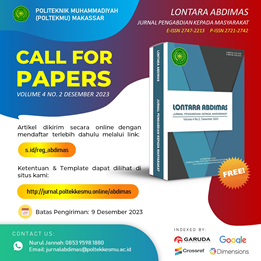Penyuluhan Helminthiasis Dan Pemeriksaan Helminthiasis Di SLB YPKS Kel. Mataallo Kab. Gowa
Abstract
Abstract
Intestinal helminth infections (helminthiasis) are a global public health problem especially in tropical countries. Helminthiasis is an intestinal nematode parasitic infection caused by Soil Transmitted Helminth (STH) and Non-Soil Transmitted Helminth (Non STH). An estimated 4.5 billion people are at risk of infection with helminthiasis. The prevalence of helminthiasis infection is high in the age of children. Helminthiasis infection will affect intake, digestive, absorption and metabolism of food so that it can cause nutritional deficiencies in the form of calories, protein and vitamins and blood loss which results in decreased endurance and cause growth and development of children. SLB YPKS Ex. Mataallo is one of the elementary schools that manages basic education with students who have physical limitations in the form of blind, deaf, and physically disabled. These conditions require the need for special assistance to increase awareness of personal hygiene in order to reduce the risk of helminthiasis infection. The purpose of this community service is to conduct counseling and identification of helminthiasis on SLB YPKS students. Mataallo using native methods. Based on the results of the examination of YBKS SLB student Ex. Mataallo as many as 37 children. using native methods and microscopic examination obtained 22 students or 59% stated positive helminthiasis. Distribution of types of worms that infect are Ascaris lumbricoides by 15 students or by 68% and Trichuris trichuira by 7 students or by 32%.
References
1. Tefera, E., Belay, T., Mekonnen, S. K., Zeynudin, A., & Belachew, T. (2017). Prevalence and intensity of soil transmitted helminths among school children of Mendera Elementary School, Jimma, Southwest Ethiopia. The Pan African Medical Journal. https://doi.org/10.11604/pamj.2017.27.88.8817
2. DT, Jaminson, JG Breman, AR Meashem. (2006). Disease Control Priorities in Developing Countries. New York: Oxford UniversityPress.https://www.ncbi.nlm.nih.gov/books/NBK11748/
3. Loukouri, A., Méité, A., Kouadio, O. K., Djè, N. N., Trayé-Bi, G., Koudou, B. G., & N’Goran, E. K. (2019). Prevalence, Intensity of Soil-Transmitted Helminths, and Factors Associated with Infection: Importance in Control Program with Ivermectin and Albendazole in Eastern Côte d’Ivoire. Journal of Tropical Medicine. https://doi.org/10.1155/2019/7658594
4. Subair Hardyanty, Hidayanti, Salam A. Gambaran Kejadian Kecacingan (Soil Transmitted Helminth), Asupan Vitamin B12 dan Vitamin C pada Anak Usia Sekolah dasar di Kota Makassar. Universitas Hasanuddin Makassar.











